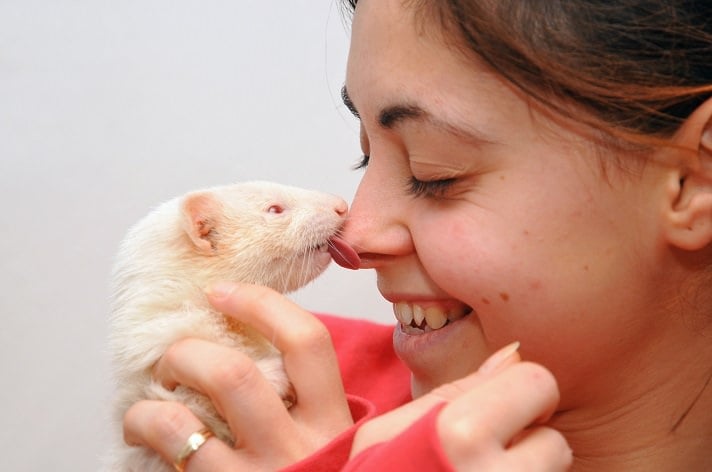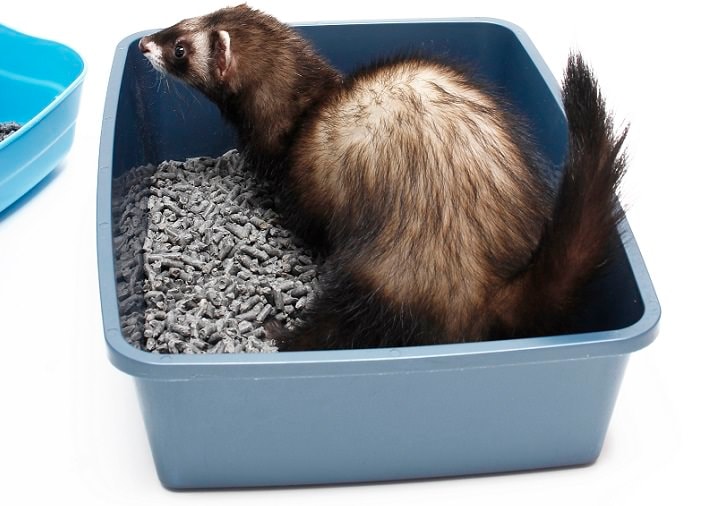Because cats and dogs are so common, most animal lovers have a good idea of what’s involved in their care. But with ferrets, it’s a different story. You can’t just assume that looking after a ferret will be the same as looking after a dog or a cat, even though you might be told that ferret care is just like cat care.
1. Life Span
When picking a pet, most people don’t stop to consider how long the pet is likely to live. But this can be an important consideration. For example, if you’re approaching your senior years, is it wise to take on a pet that could outlive you? Or, if you’re a teenager, how long will you be able to care for a pet before you’re off to college?
Did you know that dogs live an average of 12.8 years, and cats can live for 15 to 20 years? Compare that to ferrets, which have an average life span of seven years.
2. The Spay-Neuter Question
These days, with pet over-population being such a big problem, most responsible pet owners have their pets spayed or neutered. Puppies and kittens don’t usually come spayed or neutered from the breeder or pet store, so you’ll have to pick up that care cost yourself. Ferrets, on the other hand, are usually “fixed” before you buy them, and the sterilization is included in the purchase price.
Although sterilization is highly recommended for dogs and cats, it’s not absolutely necessary for their health. However, in the case of female ferrets that are being kept as pets, spaying is not optional — it’s essential. This is because jills (female ferrets) go into prolonged heat if they’re not bred regularly, and this prolonged heat causes a life-threatening condition called aplastic anemia.
3. Pet-Proofing
Whenever you bring a companion pet into your house, a certain amount of pet-proofing has to be done. If you don’t take precautions, dogs get into things that can be harmful to them, like poisonous plants and chocolate. They also raid the trashcans and chew on your slippers and socks. Cats use your plants as litter boxes and your sofa as a scratching post. They also knock knickknacks off tables and get tangled up in window blind cords. So, if you have a dog or a cat as a pet, you have at least some pet-proofing to do.
With ferrets, on the other hand, you have lots of pet-proofing to do. Ferrets have long, slinky bodies, so they can squeeze into very small spaces where they don’t belong. They’re also very dexterous, so they can open cupboard doors, drawers and zippers and get at ferret supplies or things they shouldn’t. They’ll go to great lengths to track down anything made of foam, rubber and sponge. And if they find any, they eat it. Warning! This can cause intestinal blockage because ferrets have a narrow gastrointestinal tract that blocks easily. Intestinal blockages do occur in dogs and cats, but such blockages are much more common in ferrets.
4. Vacation Care
When vacation time rolls around, you should not have much difficulty finding temporary care for your dog or cat. Family, friends or neighbors are often willing to look after Kitty or Fido, either at your house or at theirs. Professional pet sitters, too, are accustomed to looking after cats and dogs. And there are lots of boarding facilities available for these pets. With ferrets, however, the vacation-care choices are more limited.
Oftentimes, family members and friends have no experience with ferrets and don’t feel comfortable looking after one. Even if you do know somebody who volunteers to provide a home-away-from-home for your fuzzy, is his/her house ferret-proofed? Probably not. You might be able to find a professional pet sitter who’s willing to take on the job, but will he or she have any experience with ferrets? Could a pet-boarding facility be the answer? Unfortunately, it’s hard to find one that takes ferrets. And even if you are lucky enough to locate one, can the staff guarantee that your furball will get enough supervised out-of-the-cage playtime in a ferret-proofed area?
5. House Training
Most owners don’t think of house training their pets as a fun activity. But in the case of cats and dogs, the process usually goes pretty smoothly. Many kittens seem pre-programmed to use a litter box. And although some dog breeds are more difficult to house train than others, the majority of dogs catch on before too long.
Enter the ferret. You’re not going to be able to train a ferret as easily as you can train a dog or a cat. A ferret won’t tell you that it has to “go” like a dog will, and he won’t take naturally to a litter box like a cat will. Litter training a ferret takes work. Lots of work. And often lots of litter boxes. A cat will run from anywhere in the house to a single litter box to do her business; a ferret will need at least one litter box in each room he roams.
6. Homing Instinct
We have all read stories of dogs that got separated from their owners and walked incredible distances to find them.And there are similar stories about cats. They, too, have an uncanny instinct to find their way home. Most dogs and cats, though not all, have this homing instinct and can find their way back to their own address. This is especially true if they haven’t wandered very far.
But ferrets are a different story; they don’t have a homing instinct. So if your fuzzy escapes from the house, don’t wait around to see if he returns. He won’t. You need to organize a search party right away and go looking for the runaway.
7. Annoying Noise
When you own a pet, you don’t want him to be an annoyance to your neighbors. Think how mad you get when you cannot escape the incessant barking or the midnight yowling of a neighbor’s noisy pet. It can take quite a bit of time and effort to train a dog not to bark and a cat not to yowl. Certainly, some breeds of dogs and cats vocalize less than others, but if it’s a really quiet pet you’re after, this is where ferrets score big. You’re not going to get complaints from your neighbors over your ferret’s gentle “dook-dook” or his occasional squeak or bark.
8. Mine, Mine, Mine!
Many dogs and cats like to stash away food, treats and toys. And have you ever had a dog that carried off your socks, or dug up your yard to bury his chew bones? This behavior can be pretty annoying. But it’s nowhere near as annoying as the stealing and stashing that ferrets do.
Fact: When it comes to stashing and caching, ferrets are in a league of their own. Can’t find your keys in the morning? Check with your ferret. Looking for the TV remote at night? That guilty-looking fuzzy might be able to help you. Cellphones, can coolers, iPods, toothpaste, tubes of hand lotion, sunglasses, room deodorizers, shoe insoles, screwdrivers, flashlights, wallets — anything that’s not nailed down is fair game for your fuzzy. And to make matters worse, these wily weasels often hide their stockpiles in hard-to-reach places. Would it ever occur to you to look for your keys up inside the mattress box springs?
So, with a ferret, you need to be more diligent about keeping things out of your fuzzy’s reach. You also have to search for your pet’s various hoards and remove any moldy food, dangerous items or stolen goods.
9. Exercise Time
A companion pet is just like you — he needs daily exercise to stay fit and healthy. For outdoor exercise, dog owners who have a fenced yard can just open their back door and let the bow-wow out to play.
You certainly can’t do this with a ferret. He would soon sneak under the fence and take off to explore. (And, remember, ferrets can’t find their way home.) You could take your ferret for a walk on a leash, but he’s not going to heel on command like a dog, or stop and start when you tell him to. A walk with a ferret is more like a walk with a cat. It has to be a leisurely stroll, with many sniffs-and-stops along the way. With a dog, you set the pace. With a ferret, walks have to be at the ferret’s pace.
Another way to give a fuzzy some outdoor exercise is to set up a ferret playpen or exercise pen. This is similar to putting a dog in a dog run. The big difference is that a ferret must be supervised at all times during outdoor playtime. Even if you buy a cover for the pen, this isn’t a license to leave your ferret unsupervised. Ferrets are escape artists, and many of them are wily enough to weasel their way out.
When it comes to indoor exercise, the main thing to remember is that ferrets are just like dogs and cats. They need to run around and get regular playtime and exercise. The big difference is that most dogs and cats are allowed full run of the house or, at the very least, they’re allowed into most rooms of the house. This might be true for some ferrets whose owners have taken the time to properly ferret-proof each room. But more frequently, ferrets are confined to a couple of rooms and, in some cases, to a one-room play area.
10. Pets And Children
Many families with young children don’t hesitate to add a dog or a cat to the family. But if you have young children or are thinking of starting a family, a ferret might not be the pet for you. Children can be rough with small animals, and ferrets can be rough in return. Not a good combination! Ferret experts explain that baby ferrets are used to play-nipping and roughhousing with their littermates, and don’t always understand that this behavior isn’t appreciated by human playmates.
Also, fuzzies tend to be squirmier than dogs or cats, and their long slender bodies are prone to injury if squeezed or dropped. This is another reason young children and ferrets are not a good mix.
By: Gerry Bucsis and Barbara Somerville
Featured Image: Via gjohnstonphoto/iStock/Thinkstock
Share:









